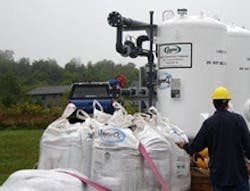Resolving Iron and Manganese Problems
Most groundwater contains some amount of iron and manganese. These naturally occurring minerals leach from rocks and soils, and in small amounts, they are essential to human health. But excess amounts in drinking water cause aesthetic problems: unwanted haze and color, stains on fixtures and laundry, harmful build-up in pipes and tanks, and an unpleasant taste.
These negative qualities make iron and manganese a problem for treatment plants, and the U.S. Environmental Protection Agency (EPA) has recommended secondary maximum contaminant levels (SMCLs) for each. The secondary limit is 0.3 parts per million (ppm) for iron and 0.05 ppm for manganese. Nobody wants noticeable levels of iron or manganese in their drinking water, including Black River Falls, Wis.
Located in west-central Wisconsin, the city of Black River Falls has a population of approximately 4,000 and is the Jackson County seat. The city installed two wells at the new Rye Bluff location, replacing two existing wells that had been compromised by floodwater.
Layne Christensen Company helped site the Rye Bluff wells in a location where the sandstone aquifer was thick enough to provide the needed capacity. However, the new wells produced water with naturally high concentrations of iron and manganese , exceeding the EPA’s recommended standards with iron concentrations of 2 to 3 ppm and manganese levels of 0.1 to 0.2 ppm.
A pilot test was performed to compare the efficacy of the available treatment options. The pilot test revealed that LayneOx performed at higher loading rates than either sand/anthracite or manganese greensand. The city subsequently specified it as the required filter media. The use of high-efficiency media helped to reduce overall cost by minimizing the size and scale of the treatment plant.
Layne provided the engineer with the design for a LayneOx-based treatment skid with a treatment capability of 255 gal per minute (gpm) using a pre-piped and pre-wired three-vessel treatment skid. This design is significant because its surface loading rate of 8.6 gpm/ft2 allows a smaller filter footprint and a smaller treatment building, efficiently removes manganese from water without any permanganate feed, is fully automated and produces lower backwash volumes than competing technologies.
Layne performed all equipment fabrication. The finished treatment skid arrived pre-piped and pre-wired for fast, easy installation and start up. The new plant was commissioned in January 2006 and is performing well, typically removing 95% of both the iron and the manganese in the groundwater.
